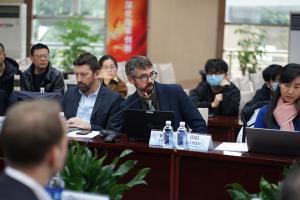Staff Stories

#make my children’s world a better place;
#USA;
#Nuclear Technology Program;
#blanket;
#local school in Jouques;
#life in Provence;
#collaboration;
Ryan Hunt is the Blanket Project Leader, in charge of one of the most critical and technically challenging components at ITER. The ITER blanket is the closest component to the ITER plasma and absorbs much of the energy from the plasma interaction. It physically "blankets" the plasma, wrapping 360 degrees around it. In his role as Blanket Project Leader, he is proud to have a large impact on the project and to be responsible for such a key component. "I can’t think of many other places in the world where I could have as much of an impact as an engineer as I can here.” Ryan believes fusion to be the energy of the future.
“I want to be able to look forward in time and say that I did everything I could to help make my two young children’s world a better place.”
His biggest challenge of late? Managing the material change in the front-facing first wall of the ITER blanket. Originally planned in beryllium, the armour of the first wall was changed to tungsten by the ITER Organization in 2023. This new approach—which has the advantage of reducing the retention of tritium inside the vacuum vessel, reducing the production of dust, and increasing the resilience of in-vessel components against disruptions—also brings challenges. “If it had been done several years earlier it would still have been difficult to do, but easier than doing it at this stage. Because of the current status of manufacturing within various procurements, the transition has required a lot of teamwork and collaboration with our different partners.”
Collaboration, which is one of the project's CARE Values, is more important than ever in Ryan’s daily work. “We had a meeting in China in 2023 where a lot of teams converged on the first wall fabrication facility. Everyone contributed openly about the constraints they face and the difficulties in realizing this mutual goal. It was a collaborative environment where everyone came with an open attitude, ready to perform and give their best ideas." In the end, an agreement was reached on the way forward after the full group, representing several nationalities and lots of different backgrounds, came together and created a proposal.

Ryan and his partner have chosen to immerse their family in local French culture, from education to cuisine, and opted to live in a picturesque village. “We live in Jouques, a small village surrounded by forest. Both of my kids were born at the local maternity hospital. The French school system is good, so we put our youngest in the local crèche (daycare) and our oldest in the village preschool and both are more or less bilingual now. Living in the woods, there’s also a lot of hiking and bike riding to do. That’s another reason to work at ITER, as there are not many places where you can work on such an amazing project and live in the beautiful countryside." Jouques also has a regular weekend farmer’s market, with great local produce. "It’s a good place to live if you like food and cooking.” For Ryan, all the ingredients are reunited—working on a challenging, important project and enjoying life outside of work with his family.
